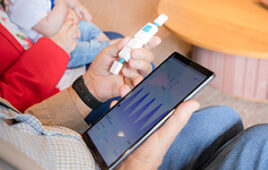
AbbVie submitted its New Drug Application (NDA) to the U.S. Food and Drug Administration (FDA) seeking approval for the company’s investigational, all-oral, interferon-free regimen for the treatment of adult patients with chronic genotype 1 (GT1) hepatitis C virus (HCV) infection. The NDA is supported by data from the largest all-oral, interferon-free clinical program in GT1 patients conducted to date, with six Phase 3 studies that included more than 2,300 patients in over 25 countries.
“This NDA submission is a significant advancement for AbbVie’s HCV development program,” said Scott Brun, vice president, Pharmaceutical Development, AbbVie. “Based on the robust data that have been generated in our international Phase 3 HCV program, we believe our all-oral, interferon-free regimen holds the potential to be a promising new therapy for patients living with this chronic infection.”
In May of 2013, AbbVie’s investigational direct-acting antiviral (DAA) regimen with and without ribavirin for HCV genotype 1 was designated as a Breakthrough Therapy by the U.S. FDA. This designation is intended to help expedite the development of drugs for serious or life-threatening conditions and is based in part on preliminary clinical evidence demonstrating a drug or regimen may have substantial improvement on at least one clinically significant endpoint compared to available therapy.
AbbVie plans to submit applications for regulatory approval of its regimen in the European Union in early May.
In the U.S., an estimated 3.2 million people are living with HCV and the infection is most prevalent among those born between 1945 and 1965.
The AbbVie investigational regimen consists of the fixed-dose combination of ABT-450/ritonavir (150/100mg) co-formulated with ombitasvir (ABT-267) 25 mg, dosed once daily, and dasabuvir (ABT-333) 250 mg with or without RBV (weight-based), dosed twice daily. The combination of three different mechanisms of action interrupts the hepatitis C virus replication process with the goal of optimizing sustained virologic response rates across different patient populations.
Date: April 22, 2014
Source: AbbVie




